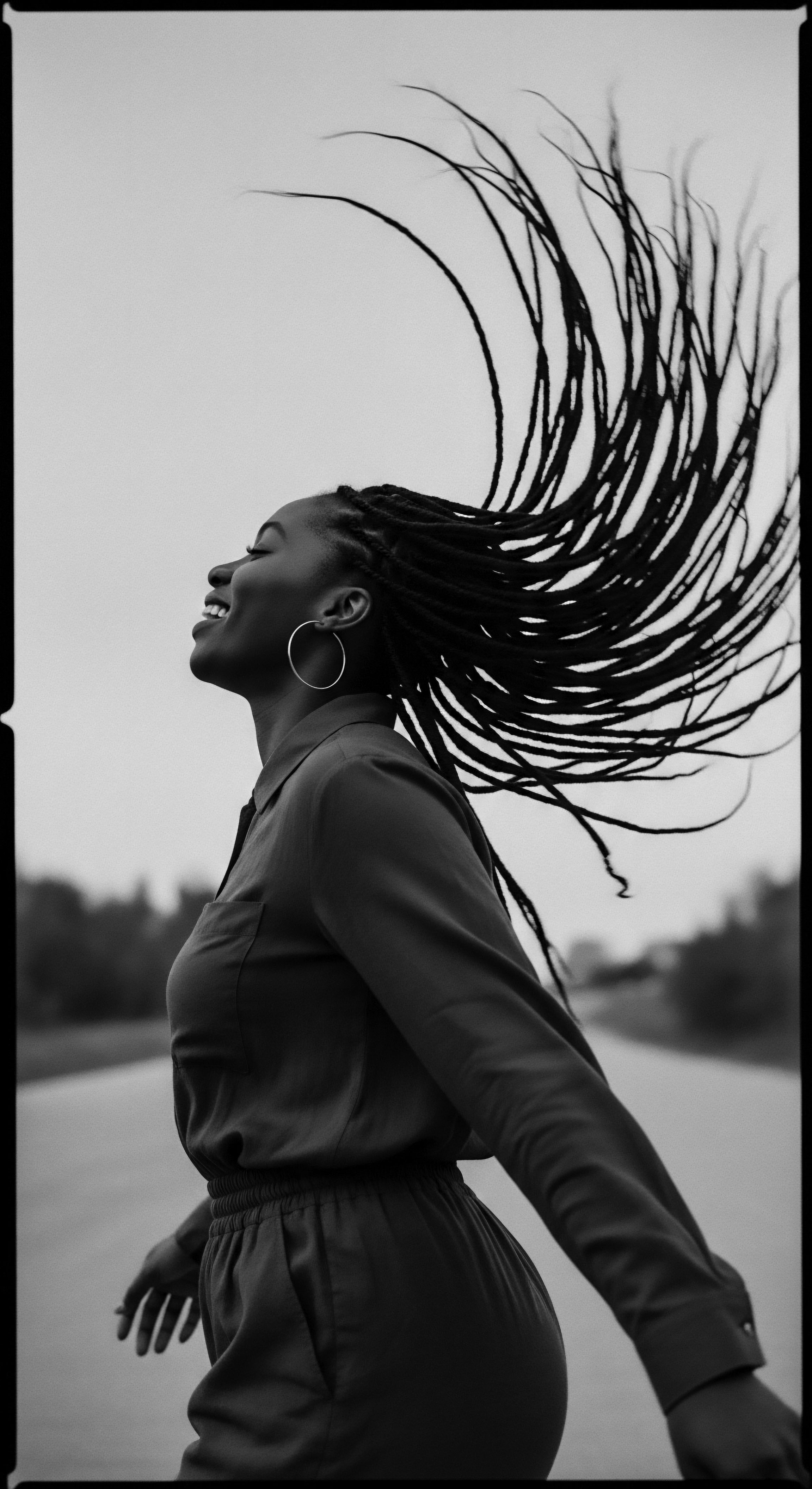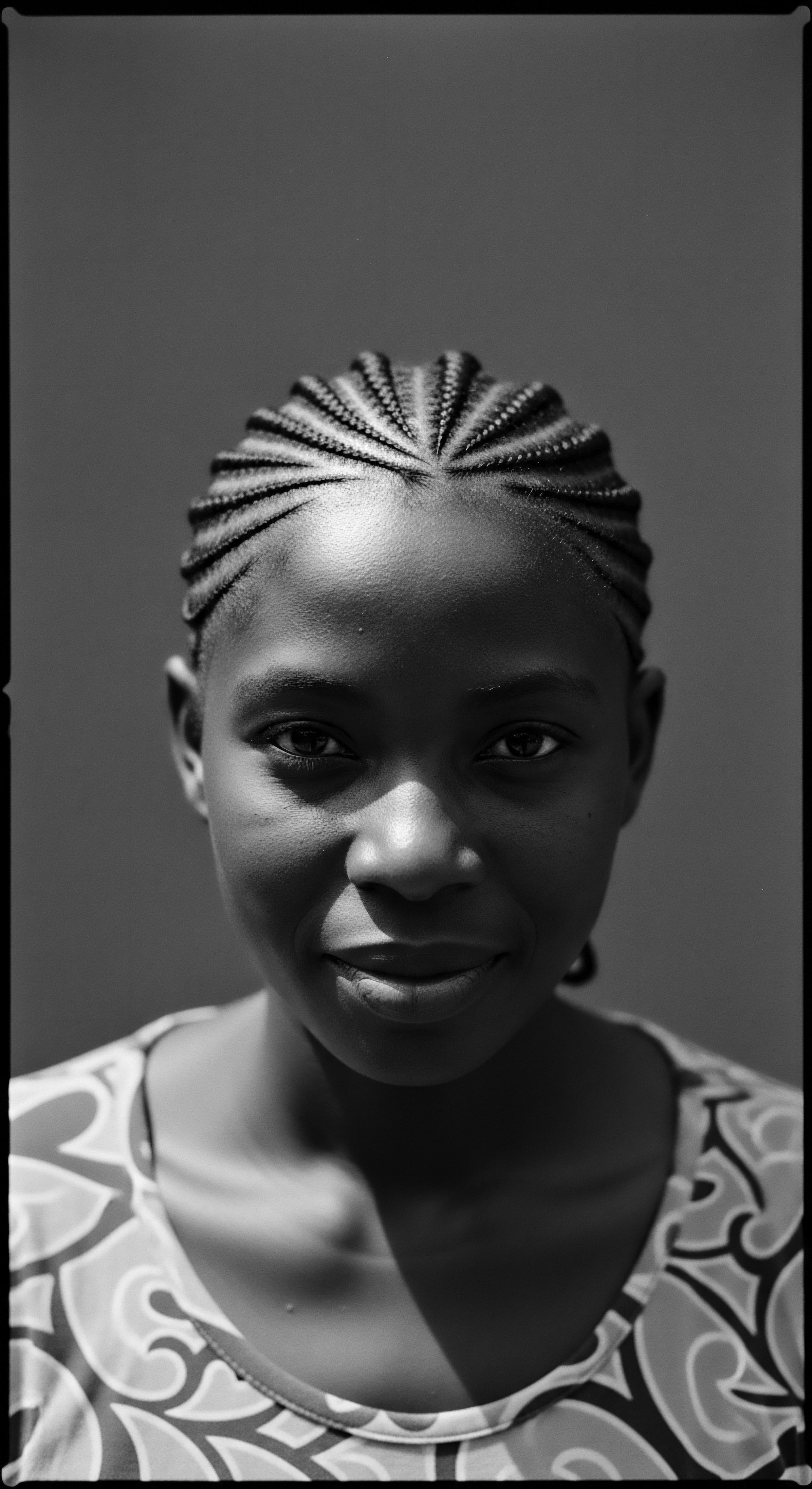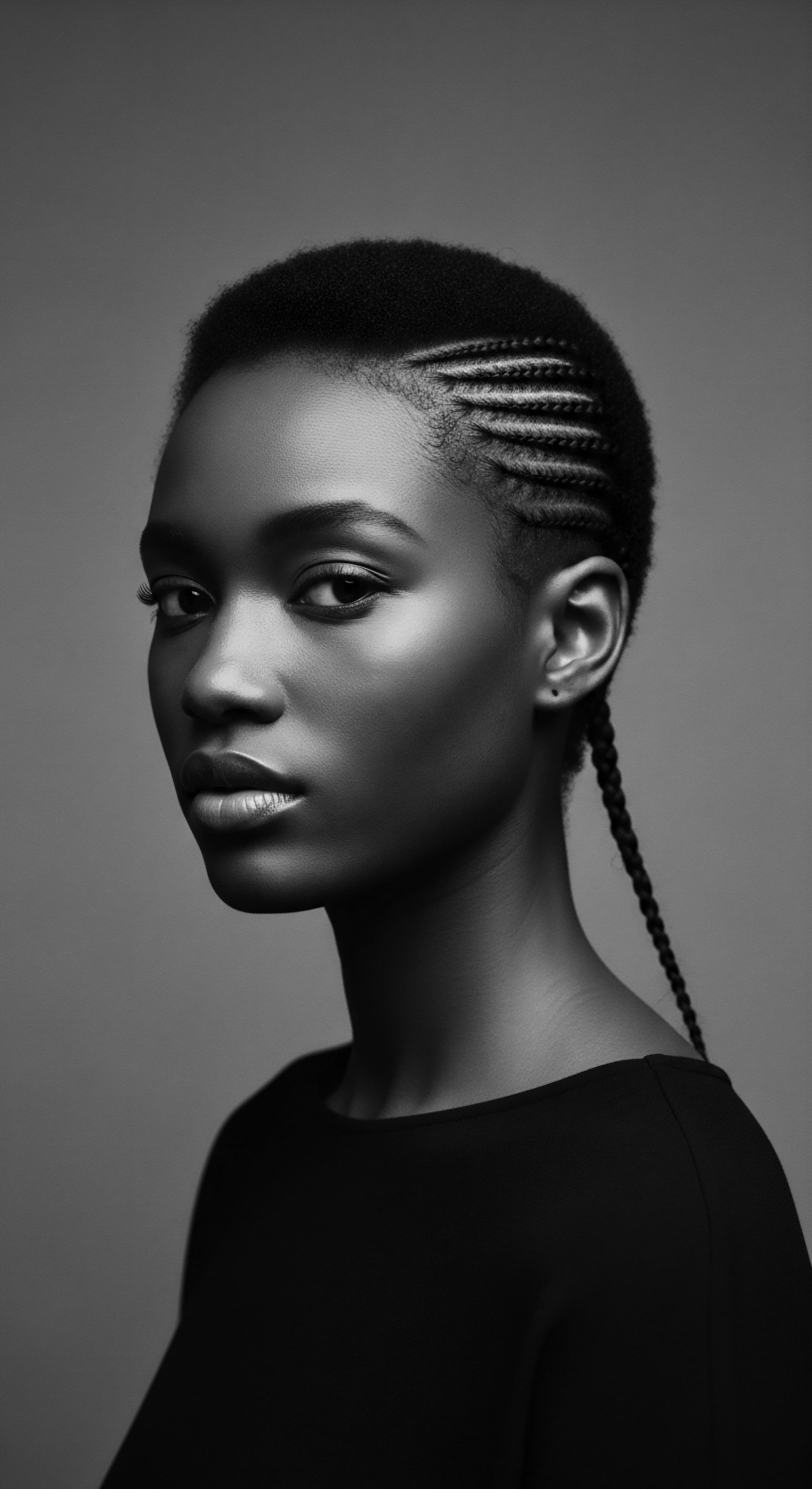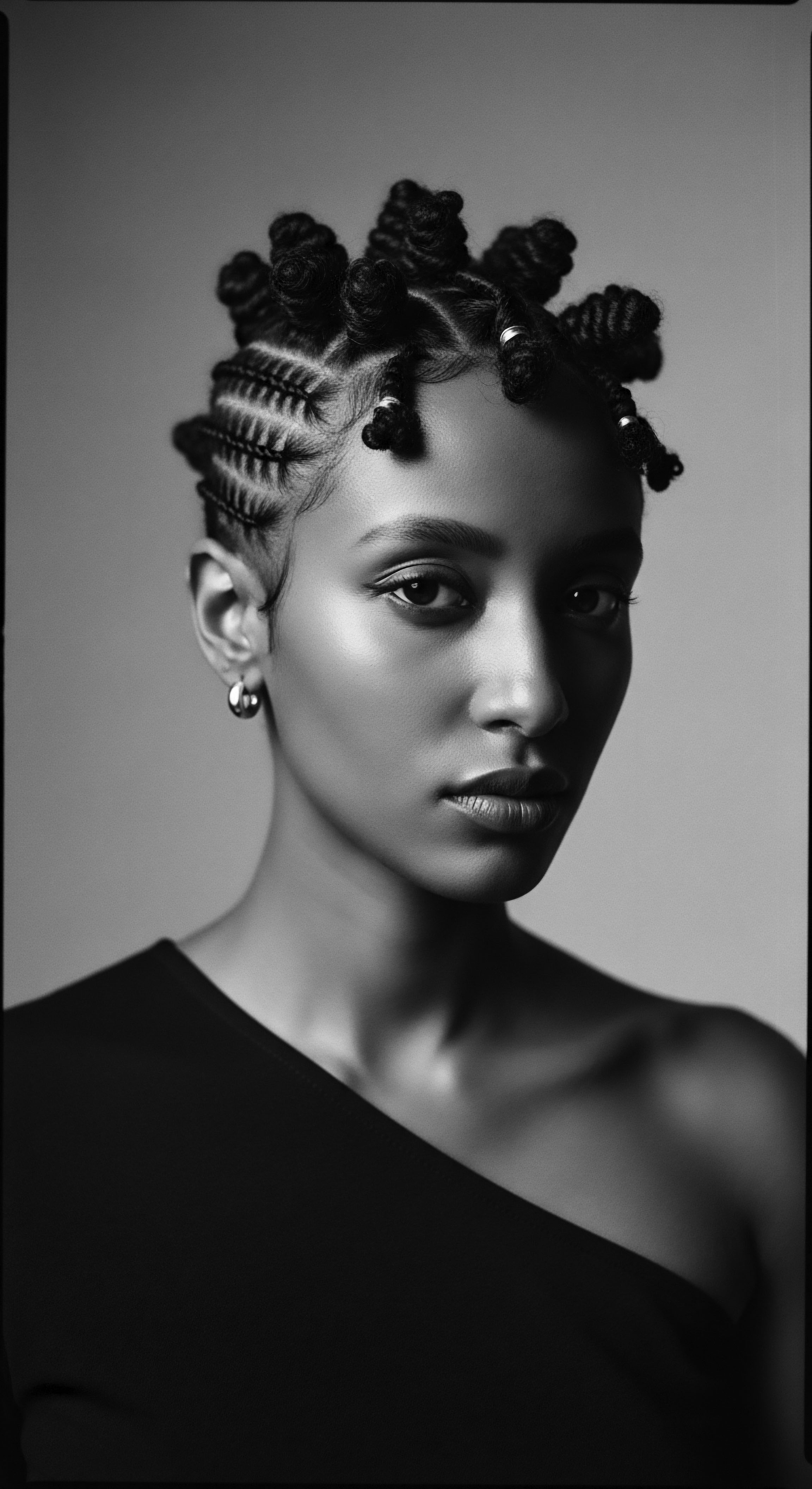
Roots
The whisper of ancestry courses through each coil, each strand, a living history etched in the very fiber of our textured hair. For generations, Black and mixed-race peoples have carried stories, resilience, and resistance within their crowning glory. It is in this profound context that we approach the enduring question ❉ how did cornrow patterns signify routes to freedom? This inquiry extends beyond a mere historical anecdote; it delves into the incredible ingenuity and deep cultural memory of a people facing unimaginable oppression.
Consider the biology of textured hair, so uniquely suited to hold its form, to retain the patterns impressed upon it. Unlike straight hair, which lacks the elliptical cross-section and higher density of disulfide bonds found in Afro-textured strands, these characteristics contribute to its natural ability to maintain intricate styles for extended periods. (Hexis Lab, n.d.). This inherent structural capacity, a gift of our genetic heritage, became a silent partner in the struggle for liberation.
The very nature of tightly curled hair, with its elliptical cross-section and retro-curvature at the bulb, lends itself to patterns that remain defined, creating raised rows that hold their shape. This characteristic was not merely a matter of aesthetics; it was a physical attribute that, in dire times, served an unforeseen purpose.

Textured Hair Anatomy and Its Ancestral Relevance
The resilience and unique morphology of textured hair are not recent discoveries. Our ancestors understood the living properties of their hair with an intimacy that predated modern scientific classification. They observed how hair responded to moisture, how it held tension, and how certain manipulations could preserve its health.
The tight curl patterns, often described in modern systems as Type 4, naturally create a protective canopy, minimizing direct sun exposure to the scalp and retaining moisture, especially crucial in diverse African climates. This anatomical reality provided a foundation for practical styling that could last, a benefit not lost on enslaved individuals who needed hairstyles offering longevity with minimal upkeep under harsh conditions.
Hair classification systems, while modern constructs, aim to describe the spectrum of curl and coil patterns present within Black and mixed-race hair. However, their origins often carry historical biases, reflecting a desire to categorize and, at times, devalue, rather than simply observe. Yet, even within these classifications, the distinctive properties of tightly coiled hair stand clear, setting it apart from hair with looser curl patterns or none at all. This inherent characteristic allowed for the creation of durable, structured designs.
The physical characteristics of textured hair provided a foundational element for the precise and lasting patterns necessary for covert communication.

The Original Lexicon of Adornment
Before the transatlantic slave trade, hair served as a profound marker of identity across countless African societies. Hairstyles were not merely decorative; they were living documents, communicating age, tribal affiliation, social standing, marital status, and even religious beliefs. The patterns held meaning, understood within communities, a silent language spoken through strands.
For instance, in Yoruba, the term ‘Irun Didi’ refers to cornrows, while ‘kolese’ means “a creature without legs,” a Yoruba term for cornrows that speaks to their appearance laying flat to the scalp. This deep cultural understanding of hair as a communicative medium laid the groundwork for its subversive application during slavery.
When millions were forcibly taken from their homes, their heads often shaved to strip them of cultural identity, this ancestral practice of hair-as-communication persisted. The oppressor, seeking to erase culture, inadvertently overlooked the very mechanism through which resistance might be sown. The act of cornrowing, already steeped in communal practice and shared wisdom, transformed from a public declaration of identity into a whispered conspiracy of liberation. The ability of cornrows to hold their shape, allowing for the meticulous charting of paths, became a testament to the enduring genius of those determined to reclaim their freedom.

Ritual
The ritual of hair styling, a deeply communal and often sacred practice across African cultures, underwent a profound transformation during the era of enslavement. What was once a joyous gathering, where stories were shared and heritage affirmed, became a clandestine act of survival, a silent agreement amongst the oppressed. This shift illuminates the adaptive genius within the traditions of care and community, particularly in the context of cornrow patterns signifying escape routes.

Styling as a Map for Liberation?
The stories persist ❉ cornrows, styled in specific patterns, were used as a means of communicating escape routes and signals among enslaved Africans. While precise documentation from the time of slavery in the United States remains scarce due to the very nature of covert resistance, compelling accounts arise from other parts of the diaspora, most notably Colombia. Here, an extraordinary individual, Benkos Biohò, a royal captured from the Bissagos Islands by the Portuguese, escaped bondage in the early 17th century.
He established a Palenque village, San Basilio de Palenque, a community of self-liberated Africans, becoming the first free village of African heritage in the Americas. Within this network of resistance, Biohò devised an intelligence system where women would create ‘maps’ in their cornrow styles to relay information without arousing suspicion.
Consider the subtle artistry of this practice. A particular number of braids might indicate an escape route, or perhaps a meet-up time. The direction of the braids could mirror the paths of trails, rivers, or mountains. The style known as “departs,” thick, tight braids tied into buns on top of the head, reputedly signaled an intention to flee.
This system relied on the everyday appearance of cornrows, which were also worn for practical reasons to keep hair tidy and manageable during demanding labor. The very normalcy of the style became its camouflage.
Hair braiding, traditionally a communal act of cultural identity, became a clandestine means of coded communication for freedom.

Concealed Sustenance and Symbolic Adornment
Beyond the visual maps, cornrows also served as practical concealment. Enslaved people would hide seeds, gold fragments, or other small, vital provisions within the tightly woven braids, ensuring nourishment for themselves or their children during perilous journeys to freedom. This act speaks volumes about the desperation and ingenuity of those seeking liberation, transforming their hair into a living survival kit.
The knowledge of how to conceal these items, how to braid hair tightly enough to secure them without causing undue discomfort or suspicion, points to a sophisticated understanding of hair dynamics and practical application. This knowledge was passed down, likely through whispered instructions during those intimate moments of hair care. The act of braiding, often a shared experience between women, transformed into a powerful conduit for collective resistance.
The ancestral roots of protective styling, of which cornrows are a prime example, were deeply practical long before their role in escape. These styles shield the hair from environmental damage, reduce manipulation, and aid in length retention, all crucial factors for individuals laboring under harsh conditions with limited access to resources. The convergence of these practical benefits with the strategic covert communication reveals a layers-deep testament to human resilience and cultural continuity.
| Traditional Braiding Technique Simple Straight Rows |
| Potential Covert Application During Slavery Could represent a direct path or a main road towards a known safe area. |
| Traditional Braiding Technique Curved or Zigzag Patterns |
| Potential Covert Application During Slavery Might denote winding rivers, specific trails, or changes in terrain on an escape route. |
| Traditional Braiding Technique "Departes" Style (Colombia) |
| Potential Covert Application During Slavery Thick, tight braids tied into buns, signaling an active plan to flee. |
| Traditional Braiding Technique Concealed Objects |
| Potential Covert Application During Slavery Hiding seeds, grains, or gold within the braids for sustenance or trade on the journey. |
| Traditional Braiding Technique The adaptability of cornrow styling allowed for both practical hair management and a powerful, hidden language of freedom. |

How Did Cultural Practices Influence the Practicality of Covert Cornrow Communication?
The communal aspect of hair care in African societies meant that knowledge of braiding techniques was widely disseminated. Mothers, aunts, and community elders would teach younger generations, creating a shared literacy of hair. This collective skill set was invaluable in the context of slavery.
It ensured that enough individuals possessed the dexterity and discernment to create these ‘maps’ or hide provisions, and that the styles would look natural, attracting no undue attention. The hours spent in communal braiding sessions, which were integral to African social life, quietly became moments for hushed planning and the transfer of vital information.
This blend of practical necessity and cultural significance demonstrates the profound adaptability of ancestral practices. The styles that once celebrated social status or tribal lineage transformed, out of grim necessity, into tools for survival, yet never losing their connection to a heritage of self-expression and community.

Relay
The persistence of the oral tradition, particularly in the African diaspora, allows the stories of cornrow patterns as escape routes to reverberate through time, even when conventional archival records are scarce. This section examines the sophisticated interplay of cultural memory, academic inquiry, and the undeniable resonance of these narratives within the textured hair heritage.

Examining the Oral Record and Historical Accounts
The difficulty in locating documented, direct evidence from the time of slavery for cornrows as systematic escape maps in the United States highlights the nature of resistance itself. Covert actions, by definition, leave few paper trails. Yet, the narratives, particularly those from Afro-Colombian communities, stand as powerful testaments.
The historian Patricia Turner, a folklorist specializing in African American studies, cautions against definitive declarations without more verification, acknowledging the challenge of substantiating such claims from that era. Despite this academic caution, the stories persist within oral histories, finding a compelling resonance in their plausibility within the context of slave resistance.
One of the most widely cited examples originates from the 17th century in Colombia. Benkos Biohò, an escaped leader, established San Basilio de Palenque, a free community. To aid further escapes, his network reportedly used women’s cornrows to chart routes and hide food. This specific historical instance, documented through oral tradition and passed down through generations in Palenque de San Basilio, provides a powerful case study.
The particular number of braids could signal escape routes, or even a meeting time, without raising suspicion. The capacity to hide small seeds or even fragments of gold within the braids supplied sustenance for those journeying to freedom. This practice speaks to a deliberate, ingenious system of communication born from desperation and a profound connection to ancestral practices.
The very act of shaving the heads of enslaved Africans upon arrival in the Americas aimed to strip them of their cultural identity. Yet, the resilience of hair practices, quietly maintained and adapted, became a testament to an unyielding spirit. Cornrows, originally symbols of identity and status in Africa, became a quiet defiance, a way to preserve cultural links and communicate in a system designed to deny them voice.
| Period or Context Ancient African Civilizations (3000 BCE onward) |
| Meaning or Function of Cornrows Signified age, tribal affiliation, social rank, marital status, religious beliefs. |
| Period or Context Transatlantic Slave Trade (Initial Enslavement) |
| Meaning or Function of Cornrows Heads often shaved to erase cultural identity. |
| Period or Context Slavery Era (Colombia, 17th Century) |
| Meaning or Function of Cornrows Used as maps for escape routes, signals for meet-up times, and to conceal provisions. |
| Period or Context Post-Emancipation to Civil Rights Era |
| Meaning or Function of Cornrows Fell out of favor due to pressure for Eurocentric beauty standards; later reclaimed as symbols of Black pride. |
| Period or Context The journey of cornrows reflects adaptability, resilience, and an enduring connection to heritage across centuries of Black experience. |

How Did Scientific Understanding Reinforce Traditional Hair Practices as Tools for Survival?
Modern hair science, while not directly addressing coded patterns, certainly speaks to the inherent capabilities of textured hair that made such practices feasible. The mechanical strength of coiled strands, due to their unique disulfide bonds, contributes to their ability to hold intricate styles for prolonged periods. This structural integrity means patterns, once braided, would remain clear for days, or even weeks, a necessary condition for a ‘map’ to remain legible over time.
The concept of protective styling , deeply rooted in ancestral practices, finds validation in contemporary understanding of minimizing manipulation and environmental exposure to maintain hair health. During enslavement, this practical aspect allowed individuals to maintain their hair with limited tools or products, while simultaneously serving a hidden purpose.
The strategic use of hair as a repository for seeds or other small objects also speaks to a deep, intuitive understanding of its physical properties. The tightly wound nature of cornrows creates a dense, stable environment where small items can be secured, less likely to dislodge or be discovered. This practical application, combining the ancient art of braiding with the desperate need for survival, highlights a profound human capacity for innovation in the face of adversity.
The persistence of these stories, even in the absence of extensive written evidence, acts as a testament to the power of oral history and cultural memory. It emphasizes that valuable information about resistance and survival was often transmitted through informal channels, understood by those who shared a common plight and a deep connection to their heritage. This knowledge, carried forward through generations, speaks to the enduring legacy of textured hair as a repository of both beauty and strength.
The physical resilience of textured hair provided an essential medium for the discreet and lasting communication of escape routes.
The stories of cornrows as escape maps also underscore the ingenuity of enslaved people in subverting oppressive systems. When writing and overt communication were forbidden or dangerous, hair became a silent, living canvas. The ability to devise such a complex system speaks volumes about the intelligence, coordination, and shared hope among those seeking freedom. It was a language of resistance, spoken through the geometry of strands, understood by those who dared to dream of liberty.

Reflection
To consider cornrow patterns as symbols of escape routes is to journey into the profound depths of textured hair heritage, recognizing its extraordinary capacity to hold stories, resistance, and the very blueprint of liberation. This exploration, a meditation on the ‘Soul of a Strand,’ reveals how a cultural practice rooted in identity and connection transformed into a lifeline. The history of cornrows, from ancient African markers of social standing to tools of survival during the transatlantic slave trade, encapsulates the indomitable spirit of a people. Each braid, each row, becomes a whispered echo from the past, a silent vow toward a future.
Our hair, in its myriad coils and patterns, carries the wisdom of ancestral mothers and fathers who navigated unimaginable hardships. It reminds us that resilience can be braided into the very fabric of our being, that hope can be hidden within plain sight, and that connection to heritage offers an unbreakable source of strength. Understanding this legacy invites us to approach textured hair not merely as a biological structure but as a living archive, a repository of courage, defiance, and enduring beauty.
As we tend to our strands today, we honor those who came before, recognizing that their ingenuity shaped not only escape routes but also the very contours of our cultural identity. We are reminded that hair, in its heritage-laden glory, remains a powerful statement of self, a continuing conversation across generations, and a testament to the unyielding pursuit of liberty.

References
- Ajao, Tabitha. “Black History Month 2022 ❉ The History Behind Cornrows.” Beds SU, 7 Oct. 2022.
- Owusu, Edward. “Cornrow ❉ A Medium for Communicating Escape Strategies during the Transatlantic Slave Trade Era ❉ Evidences from Elmina Castle and Centre for National Culture in Kumasi.” International Journal of Social Sciences ❉ Current and Future Research Trends (IJSSCFRT), vol. 18, no. 1, 2023, pp. 127-143.
- Tucker, Ashley. “The Art of Healing ❉ A Nostalgic Ode to Black Hair Braiding.” U.S. Copyright Office, 16 Feb. 2022.
- “Authenticity of American slaves using hair styling as escape plans.” Reddit, 23 Aug. 2024.
- “African Slaves Used Braids to Communicate Escape Routes in Colombia.” Ancient Origins, 30 Nov. 2022.
- “A History Lesson On Hair Braiding.” Odele Beauty, 16 Jan. 2024.
- “Historical Significance of Black Hairstyles.” PowerPoint presentation, 2022.
- Meadows, Jordan. “How Cornrows May Have Helped Free Slaves Navigate.” The Carolinian Newspaper, 5 Mar. 2025.
- “Here is the ingenious way slaves used conrows as escape maps.” YouTube, Make Your Mark ❉ History & News Makers, 29 Feb. 2024.
- “The History Of Black People Braiding Their Hair.” Mayvenn, 23 May 2023.
- Byrd, Ayana D. and Lori L. Tharps. Hair Story ❉ Untangling the Roots of Black Hair in America. St. Martin’s Press, 2014.
- Dabiri, Emma. Twisted ❉ The Tangled History of Black Hair Culture. HarperCollins, 2020.
- Westgate, Gillian E. et al. “The biology of hair diversity.” International Journal of Cosmetic Science, vol. 35, no. 4, 2013, pp. 329-336.
- Ibrahimbekova, Roza, and Anastasia S. Alekseeva. “The Biology and Genetics of Curly Hair.” ResearchGate, 28 Jan. 2021.
- “Genomic Variation in Textured Hair ❉ Implications for Holistic Hair Care.” Hexis Lab, n.d.
